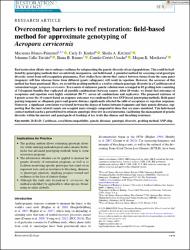| Abstract: | Reef restoration efforts aim to enhance resilience by safeguarding the genetic diversity of coral populations. This could be facilitated by genotyping methods that are relatively inexpensive, and field-based. A potential method for assessing coral genotypic diversity arises from self-recognition phenomena. Past studies have shown that contact between tissues from the same genet (isogeneic) will fuse whereas tissue from different genets (allogeneic) will result in rejection. However, the accuracy of this method has been questioned. Here, we revisit the grafting method as a tool to estimate genotypic diversity in a Caribbean coral restoration target, Acropora cervicornis.
|
| Author(s): | Blanco-Pimentel, Macarena
Kenkel, Carly D.
Kitchen, Sheila A.
Calle-Triviño, Johanna
Baums, Iliana B.
Cortés-Useche, Camilo
Morikawa, Megan K.
|
| Date: | 2023
|
| Published: | Restoration Ecology, e14073 [Early view: online version of record before inclusion in an issue]
|
| Citation: | Blanco-Pimentel, M. et al. (2023). Overcoming barriers to reef restoration: field-based method for approximate genotyping of Acropora cervicornis. Restoration Ecology, e14073. Recuperado de:
|
| URI: | https://bvearmb.do/handle/123456789/3768
|


